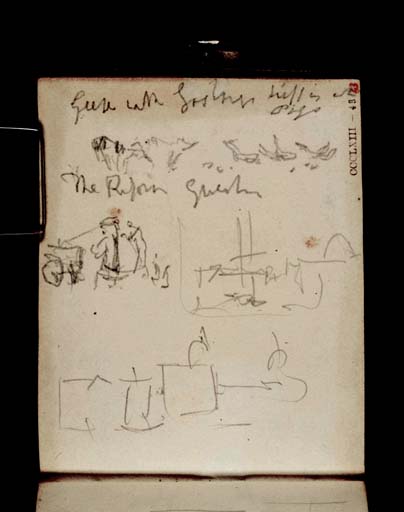Joseph Mallord William Turner Geese and Goslings Hissing at Pigs; ?Figures and a Cart; ?Greenwich Hospital c.1830
Image 1 of 2
Joseph Mallord William Turner,
Geese and Goslings Hissing at Pigs; ?Figures and a Cart; ?Greenwich Hospital
c.1830
Joseph Mallord William Turner 1775–1851
Folio 44 Recto:
Geese and Goslings Hissing at Pigs; ?Figures and a Cart; ?Greenwich Hospital c.1830
D35835
Turner Bequest CCCLXIII 43
Turner Bequest CCCLXIII 43
Pencil on white wove paper, 76 x 98 mm
Inscribed by Turner in pencil ‘Geese with Goslings hissing at | Pigs’ at top, and ‘The Reform Question’ towards top left
Inscribed in red ink by John Ruskin ‘43’ top right, ascending vertically
Stamped in black ‘CCCLXIII – 43’ top right, ascending vertically
Inscribed by Turner in pencil ‘Geese with Goslings hissing at | Pigs’ at top, and ‘The Reform Question’ towards top left
Inscribed in red ink by John Ruskin ‘43’ top right, ascending vertically
Stamped in black ‘CCCLXIII – 43’ top right, ascending vertically
Accepted by the nation as part of the Turner Bequest 1856
References
1845
A.J. Finberg, A Complete Inventory of the Drawings of the Turner Bequest, London 1909, vol.II, p.1178, CCCLXIII 43, as ‘“Geese with Goslings hissing at Pigs. – The Reform Question”; also slight sketches in harbour’, c.1845–6.
1966
Jack Lindsay, J.M.W. Turner: His Life and Work: A Critical Biography, London 1966, p.142 (Lindsay 1966a).
1966
Jack Lindsay, The Sunset Ship: The Poems of J.M.W. Turner, Lowestoft 1966, p.62 footnote (Lindsay 1966b).
With the page turned vertically, the upper third is taken up with a tiny but lively study of two or three pigs being harried by a gaggle of flapping geese. It is characteristic of Turner’s incidental thumbnail sketches of rural life and incidents, and its dual significance, immediate and potential, is amplified by his captions above and below it. He had previously introduced geese as a naturalistic yet apparently allegorical element in his watercolour Wycliffe, near Rokeby (Walker Art Gallery, Liverpool),1 engraved in 1823 (Tate impressions: T04455–T04457, T06042); there the prominent birds being shooed away in the foreground of a view of Wycliffe Hall, County Durham (associated with the medieval religious reformer and Bible translator John Wyclif) were reportedly said by the artist to symbolise ‘overfed priests’ or ‘the old superstitions which the genius of the reformation is driving away!’2
Jack Lindsay has described Turner’s linkage of an everyday incident in the animal world with pressing human issues as evidence of ‘the quizzical detachment that went with his deep feelings’3 and the ‘allegorising tricks of his mind’.4 Turner’s interest in the issues leading to the Great Reform Act of 1832 and his possible radical sympathies are addressed in the present author’s entry for the unengraved Picturesque Views in England and Wales watercolour The Northampton Election, 6 December 1830 of about 1830–1 (Tate T12321).5 Which sides of the political argument the pigs and geese might represent in this instance is unclear, but the ‘Reform Question’ appears rather more apposite to the proposed overall dating of this sketchbook here to about 1830 than to Finberg’s 1845–6 (see the Introduction).
At the centre left is a small sketch possibly involving figures and a cart. To its left and below are two sketches of classical, domed buildings, with ships’ masts in the foreground of one. They appear to relate to the page of sketches on folio 43 verso opposite (D35834; Turner Bequest CCCLXIII 42a) and, as discussed there, the slight waterfront combinations of classical domes and pediments suggest Greenwich Hospital (later the Royal Naval College).
Matthew Imms
September 2016
How to cite
Matthew Imms, ‘Geese and Goslings Hissing at Pigs; ?Figures and a Cart; ?Greenwich Hospital c.1830 by Joseph Mallord William Turner’, catalogue entry, September 2016, in David Blayney Brown (ed.), J.M.W. Turner: Sketchbooks, Drawings and Watercolours, Tate Research Publication, December 2016, https://www


